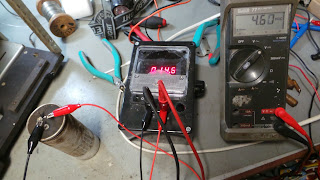This is the Panasonic SC-HTB10 sound bar. It belongs to a colleague.
"It just clicks. Can you have a look?"
Yeah , why not...
Dis-assembly involves removal of the myriad of screws from the back, there are 4 hidden under rubber bungs on the corners. The back fits really tightly, I needed to gently pry it free using a "spudger" (one of those cheap plastic tools you get for taking mobile phones apart).
This is the only time I've ever had to take a photo of a piece of kit in panorama mode!
You'll need to disconnect the sub-woofer which is in the back...
 Neat tuning port!
Neat tuning port!
Unplug the other two speaker plugs (blue and white, just by the green circuit board)
You should now be able to lift the electronics clear from the case.
Now, I'll just draw your attention to the disclaimer up there on the right of the webpage. Yep, that one. I'm doing that, because this one caught me out a bit. Under the pressed steel shield is the power supply (actually two supplies). Because of the symptoms, my guess was it was failing to start up. I carefully removed the shield and removed the supply.
Now, we can see there are two switched mode supplies. There's a small switched mode transformer above the date code, and a larger one below.
The small power supply supplies the micro-processor and control electronics. It's always on, so the remote is kept powered. This appeared to be functioning correctly.
The larger power supply, and the components in the area marked "HOT" are used to supply the amplifiers, This is where the fault lay. Despite the fact that this supply had been disconnected for many minutes, the large electrolytic still held an impressive ~300V DC. Whilst I avoided getting a shock, I was surprised to find this charge still remained. Having safely discharged the cap with a watty 10K resistor, I started a few checks. See how dis-coloured the board is around the switched mode controller and chopper IC 5701? Thing's have been running HOT! (The HOT marking on the board is to warn you that this part of the power supply is connected to live mains, and is not isolated! Not the temperature of the electronics!) Poor old C5726 had suffered as a result. It's ESR had risen to about 25 ohms... far too much for this capacitor to be in any health. A replacement was fitted and restored operation!
Another piece of gear saved from landfill
You'll need to disconnect the sub-woofer which is in the back...
 Neat tuning port!
Neat tuning port!Unplug the other two speaker plugs (blue and white, just by the green circuit board)
You should now be able to lift the electronics clear from the case.
Now, I'll just draw your attention to the disclaimer up there on the right of the webpage. Yep, that one. I'm doing that, because this one caught me out a bit. Under the pressed steel shield is the power supply (actually two supplies). Because of the symptoms, my guess was it was failing to start up. I carefully removed the shield and removed the supply.
Now, we can see there are two switched mode supplies. There's a small switched mode transformer above the date code, and a larger one below.
The small power supply supplies the micro-processor and control electronics. It's always on, so the remote is kept powered. This appeared to be functioning correctly.
The larger power supply, and the components in the area marked "HOT" are used to supply the amplifiers, This is where the fault lay. Despite the fact that this supply had been disconnected for many minutes, the large electrolytic still held an impressive ~300V DC. Whilst I avoided getting a shock, I was surprised to find this charge still remained. Having safely discharged the cap with a watty 10K resistor, I started a few checks. See how dis-coloured the board is around the switched mode controller and chopper IC 5701? Thing's have been running HOT! (The HOT marking on the board is to warn you that this part of the power supply is connected to live mains, and is not isolated! Not the temperature of the electronics!) Poor old C5726 had suffered as a result. It's ESR had risen to about 25 ohms... far too much for this capacitor to be in any health. A replacement was fitted and restored operation!
Another piece of gear saved from landfill





















































